YOU ARE VIEWING A DEMO REPORT
Angela Person

1. Client Report
Step Research
Introduction 00
Back to Table of ContentsThis is an example of some of the many different sections you can build into your clients’ reports.
We highly encourage you to ask your clients to use Polish (Report Annotator) to engage with their reports. This helps clients take action with their reports, engaging more thoroughly with the report, thinking about how type applies to their life and what it might mean. This helps make psychological type more “sticky”, they remember it and apply its lessons in their life.
Many report chapters have available client self-directed Polish activities as you can see in the How To Talk To Me chapter.
You can create as many different reports as you like. Some experts literally customize a distinct report for each client or client group; ensuring a perfect fit and very customized experience for that client.
You can change report Names, their Short Descriptions; and you have complete control over the Report Introduction. You can choose to have no introduction, in which case the clients won’t even know that this was an option, a brief introduction, or you might have several pages of instructions and/or videos.
There is a simple drag and drop tool for you to use to add, remove and reorder report sections in each report. This means that if for your process, you would rather not get into the depth of the last section in this sample report, Preference Development, then you can easily remove it.
Finally, all your reports will have your Organization Name and Logo. Independent consultants have the option of including their name and photo.
01 Cognitive Super Power - Expanded ENFP
Back to Table of ContentsThis section describes your Superpower; your dominant, "go to" behavior that is so natural, fast, and easy to access, you may not even know you have or are using it.

Energized Webs
Angela’s Superpower
- Compelled to help by generating endless ideas to change things for everyone’s benefit
- Does everything in her power to explore new and unusual possibilities, and analyze for uncommon connections
- Angela may sometimes fail to finish because she is is coming up with new additions
- She loves connecting ideas in unique, innovative ways, often making changes just for the fun of it
- Angela typically finds brainstorming a relief to finally let all her ideas out
Good Day

Change Motivator
Bad Day

Needy Monopolizer
Energized Webs
Angela is able to generate endless ideas and interconnecting thoughts, which is what Energized Webs is all about. Those with Energized Webs superpower are always thinking many thoughts that relate to interconnected webs of information. She is constantly flooded by many thoughts, ideas, and interpretations, often very unrelated to whatever is in front of her, and yet bringing in other information from outside the context that is quite likely to relevant and innovative.
For Angela, being asked to brainstorm is both a pleasure and a relief; she no longer has to keep trying to slow down the infinite supply of ideas. Like lightning strikes, Angela's ideas jump from topic to topic, which can sometimes be very frustrating to those around her when this power is overused.
Often when Angela should be focusing on getting a task done, Angela's brain is instead coming up with new and different ways to approach the task. In an argument, those with Energized Web superpower are often simultaneously playing devil's advocate for all sides.
She often finds her mouth open blurting out an idea or a connection without any need to decide if it is good or not.
Original work by: Sterling Bates Gene Bellotti © Step Research Corporation
02 Visual Type™ and Go-To Behaviors ENFP
Back to Table of ContentsThis section is a visual model of Carl Jung’s Psychological Types showing how you use all eight behaviors and which two are dominant for you.
Visual Type™ provides a visual guide to the predictive use and accessibility of each behavior and an instantly recognizable way to see differences between people. This helps individuals with self-awareness. It also helps others understand what they can expect from the individual. The goal of this section is to make it immediately obvious to non experts how the functions relate to each other and the person based on their whole type.
Invent
Look to the new and different ideas and explore many possibilitiesAngela uses brainstorming, a verbal questioning to identify patterns that provide insight. Angela looks to Invent as her go-to behavior for gathering information, she prefers seeking answers through brainstorming, identifying patterns and innovation. Angela looks outside the box for answers, seeking something new.
Value
Decide based on ethically right or wrong and sync with individual valuesAngela aligns personal missions with being understanding. She decides in a way that promotes win-win solutions with the priority on other people's feelings and her own personal ethics and morals. Angela makes decisions that focus on what is right or wrong according to her internal values. Angela then expresses her internal values through external actions.
Understanding Angela's Visual Type™
- Angela's largest go-to box is Invent: showing her strength of being able brainstorm new ideas, start new projects, think out of the box and find creative solutions to problems.
- Angela's supporting box is Value, below the line, which may be unseen by others unless she verbalizes how her ideas are supporting or undermining her deeply-held values.
- Angela's other three top boxes - Now, Execute and Consideration - are drafted to support her Invent function, which she experiences as her Energize Webs Superpower.
You use all eight Go-To boxes but we expect that you find certain ones easy and fun and others slow and tough.
Think of the box size as telling you how natural you are likely to find activities related to that mental function. The smaller the box, the more energy it will likely take you to do any related activities. The bigger the box, the more likely you are to get energy from doing related activities.
The largest box is your largest function or Superpower.
The boxes above the line are what other people see - they are extraverted. The boxes below the line are introverted and are below the surface.
If your main go-to box is introverted, your most commonly used mental function is invisible to others. If your main go-to box is extraverted, others cannot see your supporting introverted box.
- Exciting
- Quick acting
- Risk taking
- Details
- Immediate need
- Exciting
- Quick acting
- Risk taking
- Details
- Immediate need
- Remembering
- Tells it from beginning to end
- Recalls in time sequence
- Details
- Nothing is too old
- Remembering
- Tells it from beginning to end
- Recalls in time sequence
- Details
- Nothing is too old
- Sharing ideas
- Takes a global perspective
- Brainstorming
- Identifies patterns
- Is not bothered by details
- Sharing ideas
- Takes a global perspective
- Brainstorming
- Identifies patterns
- Is not bothered by details
- Gaining insight from the unknown
- Having the “AHA”
- Connects the unconnected
- Difficult to explain
- Processes randomly
- Gaining insight from the unknown
- Having the “AHA”
- Connects the unconnected
- Difficult to explain
- Processes randomly
- akes a removed or objective perspective
- Sounds level headed
- Works from a defendable position
- Uses external tools
- Arranges data logically
- akes a removed or objective perspective
- Sounds level headed
- Works from a defendable position
- Uses external tools
- Arranges data logically
- Invisible to others
- Everything is connected
- Developed with precision
- Nothing exists unless it is complete
- Systematic process
- Invisible to others
- Everything is connected
- Developed with precision
- Nothing exists unless it is complete
- Systematic process
- Everyone is at peace
- Wants everyone to be happy
- Appreciates others’ involvement
- Harmony in the moment
- Connecting with others
- Everyone is at peace
- Wants everyone to be happy
- Appreciates others’ involvement
- Harmony in the moment
- Connecting with others
- Shielded from others
- Timeless
- Peace within
- Going it alone
- Often visible only when violated
- Shielded from others
- Timeless
- Peace within
- Going it alone
- Often visible only when violated
Now
: Look to the present and immediate needs and explore what is currently availableNow is very adept at identifying details about something that is happening right now and can be acquired through the five senses. People using NOW tend to be very aware and in the moment, seeking tactics that they can implement right now. Now looks to the present and the immediate moment for solutions.
Engaging to Experience
Alive in the moment and aware of what the senses are able to immediately experience
What's Happening Now
Alive in the moment and aware of what the senses are able to immediately experience
The Now function triggers an immediate reaction to or an engagement of what is perceived, so it may appear as if one is quickly changing from one activity to another or shifting interest quickly from one thing to another.
People who prefer to or naturally use Now to acquire information report liking to "live life to the fullest" or "live on the edge". Often the physical risks are exciting. They also report doing things or saying things that get a recognition or a reaction from others in the moment.
Stabilize
: Look to the past, traditions and what worked and focus on consistencyStabilize is abot keeping an internal database of details that have been learned in the past. Stabilize compares today's data with past data to make an informed decision. People using Stabilize tend to check their memory, make comparisons to the past, and in general look to the past to verify information.
Reliving to Verify
Recalling the details of past experiences and reliving the motions that accompany them
Resurrecting the Past
Recalling the details of past experiences and reliving the motions that accompany them
When active, Stabilize might appear to be slow in responding or unmoved by the present moment. This is because the focus is not on the present event. Instead it is on examining all past similar experiences.
When people who prefer, or naturally use, this mental function share the experience it is as if they were sharing the video tape that is playing in the brain. They also know that the devil is in the details, so expect them to be uncomfortable leaving out the details when they are talking and wanting you to include the details when you are talking.
Recognize that the experiences being recalled may have occurred eons ago, yet they are being talked about as if they only occurred yesterday.
Invent
: Look to the new and different ideas and explore many possibilitiesInvent is about brainstorming, a verbal questioning to identify patterns that provide insight. People using Invent tend to prefer seeking answers through brainstorming, identifying patterns and innovation. Invent looks outside the box for answers, seeking something new.
Recognizing Patterns and Possibilities
Creating possibilities for the future and spontaneously recognizing patterns and connections
Envisioning to Improve
Creating possibilities for the future and spontaneously recognizing patterns and connections
Invent when active in a positive way tends to view the opportunities and possibilities positively. Information shared through this function may seem to be superficial or broad brush as the details or what is beneath the surface can be filled in later. The expressions tend to be global in nature.
Insight
: Look to how things connect, the future and predict possible outcomesInsight is about the process of identifying seemingly disconnected patterns to result in instant insight into a problem or situation. When using Insight people tend to visualize their goal or end result, focus on strategy, synthesize data almost unconsciously and predict results with surprising accuracy. Insight looks to and visualizes the future for answers.
Discerning the Essence
Synthesizing information and identifying the central theme, vision, or significance
Insight of Holistic Meaning
Synthesizing information and identifying the central theme, vision, or significance
The insights that are received are like nuggets of gold; however, often the person receiving the nugget does not know how to immediately explain it to others so that they perceive it as a nugget of gold as well. This is often because the nugget appeared as a flash of light or insight without supporting information, so when one attempts to explain why the insight should be trusted the mind is blank. Reflection time is almost always needed to allow some bits of information to drift into consciousness to support the value of the insight. Memory is symbolic and images and ideas are ever-changing.
Execute
: Decide based on measurable goals and drive towards objectivesExecute is about plans, organizing, schedules, and measures. Execute structures the decision-making process by directing and interacting with other people. Execute focuses on measurable goals. When using it, people tend to think out loud, notice quickly when something is out of sequence or order, set objectives and criteria for success, and create step-by-step procedures. Execute looks to influence and organize the world, even when not solicited to do so.
Planning and Regulating
Establishing goals and applying objective analysis to arrive at a logical, defendable decision
“Operationalizing”
Establishing goals and applying objective analysis to arrive at a logical, defendable decision
With Execute everything is supported with logically analyzed data. Execute analyzes information within specific boundaries. Western states are different from northeastern states. We can think of Execute as establishing boundaries for the problem or boundaries regarding information that will be considered. Execute involves living by specific rules, regulations and laws and believing others should, as well.
Analyze
: Decide based on logically correct or incorrect and evaluate the best approachAnalzye is about using an internal, logic-based decision-making process that focuses on what is correct or incorrect. When using Analyze people tend to look inside before making decisions, using their mind to create order, to organize and categorize information, identify anomalies, deduce probabilities and understand how things work.
Understanding Systems
Repeatedly applying system analysis to data to fit them in one’s subjective mental framework
“That’s Better Defined This Way.”
Repeatedly applying system analysis to data to fit them in one’s subjective mental framework
These frameworks are built with precision and take a long time to be completed; therefore, they are not going to be quickly discarded in favor of a different framework. Because this is an introverted function the framework or system is not visible to others. Others often do not get a glimpse of the framework until they arrive at a decision that is not consistent with the framework, at which time they get to witness the volcanic explosion.
One can think of Analyze as an internal filing system. Each file contains sub-files, which contain sub-files, and so-on. Thus, when one is using Analyze, the time it takes to evaluate information may take a substantial amount of time, as the person must check to see if the information fits within one's complex filing system. If there is no place in the filing system for the piece of information to go, it will be rejected until more information is received.
Consideration
: Decide based on people's needs and empathize with othersConsideration is about giving the other person's personal needs high importance in making a decision. Consideration gives priority to the feelings of others. When using Consideration people tend to be friendly and considerate, try to create harmony between other people, act with kindness, and will disconnect with people who do not show that they care. Consideration looks to help others grow.
Affirming and Validating
Expressing appropriate concern and appreciation so group harmony is maintained
“You Really Did a Great Job”
Expressing appropriate concern and appreciation so group harmony is maintained
Consideration is genuinely 'other focused.' It is the mental function used to assess how others will react to certain decisions. It involves knowing the appropriate thing to do and is satisfied when others are content and working together.
This function evaluates based on the possible impact on others. It strives for peace externally or peace among others and is about making sure others are not disturbed, annoyed or in conflict. Consideration involves conversing and connecting with others, being with others, appreciating others and celebrating with others. It's all about 'others.'
Value
: Decide based on ethically right or wrong and sync with individual valuesValue is about aligning personal missions with being understanding. Value decides in a way that promotes win-win solutions with the priority on other people's feelings and their own personal ethics and morals. When using Value people tend to make decisions that focus on what is right or wrong according to their own internal values. They then expresses their internal values through external actions.
Liking or Disliking
Feeling internal tranquility when reality matches what is uniquely and deeply valued
“This is the Only Acceptable Way”
Feeling internal tranquility when reality matches what is uniquely and deeply valued
These values are shielded and protected from attack by others and thus may make us feel alone, vulnerable, or even on the defensive. There is a bit of mystery as to who this person is and there is a sense of tranquility and personal serenity. The values involved change very little, if at all, over time.
When these values are attacked, the reaction is often as shocking to those triggering the reaction as it is to the one who is reacting. It is as if a sudden, unexpected explosion has occurred that is the opposite of the serene inner harmony that is generally sought. Value strives for peace internally or an internal calmness and sense that everything is right.
Original work by: Sterling Bates Gene Bellotti Robert McAlpine © Step Research Corporation
03 Engagement Styles ENFP
Back to Table of ContentsThis section describes how you prefer to interact and engage when you are working with others in order to help you realize how you can make the biggest, most significant contributions.
Angela's Engagement Style:
- Your dominant engagement style describes how you prefer to interact and engage with others, especially when working on a project.
- Your engagement style can be helpful in identifying how you prefer to interact with teammates and how you make your best contributions.
- Each engagement style has several key opportunities for making a project successful.
- When an engagement style is overused, then that style can create threats to a project's success.
| Opportunities | Threats | Score | |
|---|---|---|---|
 Carefully Understand
Carefully Understand
|
Opportunities
|
Threats
|
5 |
 Refine for Perfection
Refine for Perfection
|
Opportunities
|
Threats
|
30 |
 Dynamically Explore
Dynamically Explore
|
Opportunities
|
Threats
|
55 |
 Organize and Direct
Organize and Direct
|
Opportunities
|
Threats
|
10 |
Original work by: Sterling Bates Gene Bellotti © Step Research Corporation
04 Interaction Styles Comparison ENFP
Back to Table of ContentsShowing how you tend to use all four interaction styles.
Angela's Interaction Style:
Energizer - Get-Things-Going
Chart-the-Course
To see movement and progress
Don't see progress
Get-Things-Going
To move things along
Feeling unliked or not accepted
Behind-the-Scenes
To integrate and harmonize
Pressed to decide too quickly
In-Charge
To see action taken
Nothing being accomplished
05 How to Talk to Me ENFP
Back to Table of ContentsSpecific tips on how to better communicate and talk with each person
How to talk to Angela:

Enthusiastic & Insightful
“Let’s do it in a different way”
Motivating Words
- Create
- discover
- reform
- imagine
Angela responds best to communication when you:
-
Show a personal interest
Start by asking how Angela is doing. Remember that harmony, a positive attitude and an authentic relationship between you is essential.
-
Present the vision
Explain how Angela fits with the vision in a meaningful way. Remember to focus on why what you are talking about is important for human growth and development. Talk about the “higher purpose”. Present options.
-
Present the big picture
Talk about concepts and themes and clarify correlations and context. Be associative, not sequential. Avoid too many details unless Angela requests this.
-
Focus on the long-term perspective
Be future-oriented. Talk about new solutions and opportunities for development of human potential – especially in the long run.
-
Be open
Acknowledge initiatives concerning new and different ways of doing things. Do not turn down ideas too fast. Challenge the imagination. Ask open-ended questions.
-
Make conversation
Avoid talking too much without Angela being involved. Dialogue is the most important tool for Angela. Show interest and empathy. Tone down your language.
-
Incorporate values
Consider values and needs of people as important data. Allow and invite personal views and idealistic thoughts.
-
Give sincere compliments
Appreciate the ideas and unique role of Angela, and remember to praise contributions to the process and personality not just accomplishments.
Original work by: Mette Babitzkow Boje Tina Brøndum Kristjánsson © Step Research Corporation
06 At Work Guidance ENFP
Back to Table of ContentsThis section gives you tips about how to improve interactions with your colleagues, managers and subordinates at work.
Why it is important: Many people crave personalized guidance and mentoring at work - and this section provides just that in an automated fashion that is available on demand anytime a need arises. This guidance will help individuals, and their managers, be more effective at work.
Communication At Work Guidance
Talking to their Manager
For Angela, being able to consider the diverse perspectives in the situation and talk with her manager is very empowering. She does well when she feels that her manager is authentically looking for new ideas and is interested in her opinion. Being able to deliver a flood of new ideas and the ability to jump from topic to topic can sometimes overwhelm managers who take a more methodical approach.
Talking to Colleagues and Staff
Angela is typically great at getting coworkers engaged with the mission and linking their passion to the goals at hand. She tends to bring in many other topics to help make her points and all the wandering around in the conversation can leave others who just want to get working frustrated.
Difficult Conversations
For Angela, dancing all around related, and even distantly related issues is natural. Her ability to see how different issues are related is typically amazing. This can sometimes result in a disjointed conversation for the other person as Angela jumps from topic to topic.
Doing Presentations
Angela is typically a great speaker. While she might frequently stray from the documented presentation Angela is typically good at reading the audience and finding new ways to keep them engaged. Angela generally likes presentations that are about encouraging and motivating other people and can sometimes be frustrated when there are too many restrictions on the presentation.
Managing At Work Guidance
Setting Goals
Angela is probably very comfortable coming up with many options and ideas to use for goals. Her goals are likely to be very self motivating and include activities she enjoys. The part Angela may struggle with is that with all these options she may sometimes struggle to narrow it down.
Team Building
Angela is typically good at talking with team members, inspiring them and getting them excited about what they are doing on the team and the future goals. Angela is often good at getting team members passionate about their jobs. This focus on excitement and future possibilities can mean that sometimes Angela is not as good at following up on all the details of team members.
Leading
Angela is likely to lead by building excitement and enthusiasm by those involved in the mission. She is probably very focused on the future and new ideas. Her focus on ideas and excitement mean that sometimes she doesn't spend as much time as needed on keeping track of details and following up.
Delegating
Angela is probably good at encouraging creativity and talking to those she delegates to. She is likely to spend more time on ideas and adapting and less time worrying about small details or creating a detailed plan. For Angela, this can sometimes mean that others needing more stability are frustrated by the frequent changes.
Growing At Work Guidance
Time Management
Angela is likely very comfortable in environments with lots of flexibility and change in the schedule. Angela will probably enjoy shifting her focus many times through the day rather than sticking to rigid schedule. Angela may sometimes be so distracted by all the projects that she might not stick to schedules.
Getting Feedback
Angela is likely to be quick to come up with ideas and discuss options for addressing the feedback. Angela will probably respond well to feedback that focuses on what is going right and frames adjustments as not being personal.
07 Preference Development ENFP
Back to Table of ContentsThese describe various activities and exercises for your development.
You have the capability of building skills related to your natural preferences – the ones you have in your type code – as well as the preferences you do not have in your type code. Most people have, through their lives, naturally built skills in the areas their preferences have drawn them towards. More often, it is therefore the preferences they do not have in their type code where training would be beneficial.
Once you have developed skills within all eight preferences, you can more easily choose the behaviour that is most appropriate in any given situation. Thus, you will expand your "behavioural toolbox" as well as find that the use of a trained preference does not require as much energy.
Preference for Extraversion
The opposite is called IntroversionYour Strengths:
- Energised by the outer world
- Talk, think, talk
- Action
- Breadth
This means you typically look like this to other people:
- Talk a lot – and often loud and fast. Respond quickly.
- Process out loud so others tend to know what they are thinking. Develop ideas through discussion.
- Interrupt when you are speaking – seem eager or impatient.
- Discuss a variety of subjects at the same time and move quickly from one topic to the next.
- Pay attention to the external world – get distracted easily.
- Use body language, gesticulate and share their energy outwardly.
- Take initiative in making contact with other people – use eye contact, small talk, often start a conversation.
- Push to get started right away – action oriented. Do not need much reflection time. “Shoot from the hip”.
- Contribute enthusiastically when working in groups. Want to learn new tasks by talking and doing.
- Have a broad social network and a variety of interests.
- Do not seem to mind interruptions when working.
- Prefer spoken communication rather than written communication when they are free to choose.
This means your opposite typically looks like this to other people:
- Listen more than they talk – and often speak calmly. Talk more in one-on-one situations.
- Process internally – when talking, they most often only convey the essence/conclusion of their chain of thought.
- Pause in the conversation – and shut down if you interrupt them. May seem withholding.
- Talk in-depth about one subject before moving to the next.
- Sustain concentration and focus for long, and they may seem like they are in their own world.
- Calm body language – seem reserved.
- Limit social interaction with other people to what is “necessary”.
- Seem cautious and hesitant – they need time to reflect before acting.
- Enjoy working alone and like quiet surroundings. Want to learn new tasks by reading and reflecting.
- Have few but close relationships and explore interests in-depth.
- Seem to be disturbed by interruptions when working
- Prefer written communication rather than spoken communication when they are free to choose.
Areas for development that are typical challenges:
LISTEN MORE
Ways to develop:
“Listen-more-day” – Plan a “listen-more-day”. Reflect. Say only something when necessary. Give others time to answer and find peace in silence. Pause at least ten seconds longer than you normally would before you say something. Note what happens with the dynamics in the conversation.
Do not interrupt – For one day focus on not interrupting. Let people finish talking. Do not interrupt in the middle of an argument. Stop yourself if you accidently do it anyway. Get feedback from other people on how being interrupted affects them.
Listen to understand – Pick out a planned conversation. Listen to what the other person is saying. Practice staying attentive to his or her inputs rather than thinking of what you will say in response. Listen to the other person's point of view and describe what you heard before you allow yourself to talk about your perception and point of view.INNER PEACE
Ways to develop:
Find peace of mind – Take lessons in meditation, breathing techniques or mindfulness. Practice. Set aside time each day or week to visit your inner world. Learn to feel comfortable in your own thoughts and feelings.
Spend time alone – Say “no” to a social activity or event you would normally say yes to. Make a list of things you like doing alone and do this instead. If you need inspiration, ask a friend who prefers I.
Clarify thoughts alone – Reflect on the importance of an experience or an event by yourself. Contemplate impressions by yourself. Make an important decision alone. Practice clarifying your thought without speaking to others.DEPTH AND FOCUS
Ways to develop:
Seek depth in conversation – Pick out a person at a social event and talk in depth about a subject one-on-one. Everyone has something they are better at than you or an interest in something you do not know about. Find out what it is and let them be the ones that talk the most.
Examine in dept – Identify various subjects that interest you. Instead of breadth go into depth with one of the subjects. Allow more time than you think is necessary. Be patient and "look for the nuances."
Create a framework for focus – Pick out a task to work on alone. Find a quiet place where you will not be disturbed. Plan your breaks and stick to them. Control your craving for variation. If you feel the urge to talk, talk to yourself.REFLECTION
Ways to develop:
Communicate in writing – Resist the temptation to choose verbal communication just because it is possible. Pick out three situations during the coming week where you would normally meet with or call a person and communicate in writing instead.
Think before you speak – Think through what you want to say and what your opinion is before you start talking. Consider writing down your thoughts, summarise and only convey the “essence” of what needs to be said.
Reflect before acting – Do not accept or engage in activities you would normally throw yourself into. Turn your thoughts inward and reflect whether it is the right thing to do as well as whether it is the right time and place.
Preference for Intuition
The opposite is called SensingYour Strengths:
- Future
- The big picture
- Visionary
- The sixth sense
This means you typically look like this to other people:
- Talk about opportunities, new ideas, concepts, patterns, visions and coherences – “what could be”.
- Present the big picture first. Talk in general and abstract terms – use metaphors and speak figuratively.
- Refer to things as being “intuitively correct” or that something “could theoretically work”.
- Ask for the underlying ”meaning” and the context of an issue. The overall purpose.
- Appear to lose interest if too many details are presented in a story.
- Often say “Imagine that…”. Point out if something is unambitious and want to think big.
- Begin their story at the end and articulate the totality, skip around easily in the story and may miss some parts. Intuitive hunches.
- Interested in new ideas and new solutions – because they are new. Talk about changing things – not just improving them.
- Quickly become enthusiastic about a new idea. Trust their intuition and theories.
- Seem reluctant to do the same thing twice and follow a routine unless they have to – prefer to do it in a new way.
- Seem more engaged when a task requires a new and creative approach.
- Do not ask for instructions when assigned a new task – want to solve it in their own way
This means your opposite typically looks like this to other people:
- Talk about real life, people they know, things that have happened or will happen, the here and now – ”what is”.
- Present the facts first. Talk in precise terms, use detailed descriptions, similes. Have a straightforward speech pattern. Speak literally.
- Refer to common sense and experience and what is feasible.
- Ask about the facts and details of a case/situation.
- Appear to lose interest if it gets too hypothetical and airy fairy.
- Down-to-earth. Point out if something is unpractical or unrealistic.
- Start their story at the beginning and build it in a linear fashion, step by step. Explain in detail.
- Seek practical and efficient solutions. Talk about improving things – not changing them.
- Unlikely to embrace new ideas unless they are grounded in reality – they will ask questions about ”how”. Trust tangible data and facts.
- Seem reluctant to change the tried and tested unless it is necessary – refer to what works.
- Seem more engaged when a task requires skills already learned.
- Ask about “what” and “how” when assigned a new task – would like to know the established way before deciding how to tackle it.
Areas for development that are typical challenges:
FOCUS ON WHAT IS
Ways to develop:
"Sensing-day" – Plan a "sensing-day". Use your five senses for a whole day and focus on the real, the tangible, the observable. Note the details of real life. Be present in the moment and not in the future.
Stick to the issue – Pick out three conversations you have planned. During the conversation, focus 100% on the subject you are discussing. Push away any associations and do not interpret and “read between the lines”.
Facts – Read a short article or a memo, or ask a person who prefers S to tell you a story. Afterwards, write down the facts that were given. Crosscheck to see how accurate you were in retaining facts and not making inferences about the facts.PARTICULARS
Ways to develop:
Focus on the details – Proofread this card (or something else) in detail. Read from the the bottom to the top, right to left, word by word. (Did you spot the error in the second line?)
Practice the details – Buy a big puzzle and use at least 20 minutes a day to put it together. Or develop a hobby that requires attention to detail such as knitting from a given pattern, cooking following the recipe closely or painting by numbers.
Follow the instructions – Practice reading and following step by step instructions. Follow an instruction manual at work, install and learn a new computer program or assemble a piece of LEGO or a piece of furniture from IKEA. Do things in the way shown in the instructions. Resist the urge to do it your own way or jump around.REALISTIC AND CONCRETE
Ways to develop:
Be realistic – Brainstorm and write down your ten best ideas. Pick out two or three ideas and write down how they could be implemented. Use facts to support the usefulness of the ideas. Are they realistic? Introduce the ideas to a person who prefers S. Request feedback.
Be concrete – Tell someone a story or tell about your day at work. Tell in a straightforward way what happened and communicate chronologically and in detail. Use literally concrete words. Avoid metaphors. If you use a figurative statement, convert it to a literal statement.
Task breakdown – Pick out a big task and break it down into small tasks. Write down. Make each task specific, actionable and in succession. Estimate how long time each task will take. Start from the beginning and finish each task before moving on to the next.RESPECT WHAT IS
Ways to develop:
Resist the urge for change – Next time you notice something that needs changing, write down what is currently working. Avoid changes and "improvements" if there is no compelling reason to initiate them. Focus on only changing what is necessary.
Use routines – Make a note of what you do in the morning before leaving for work. How much of this is routine? Does having a routine make the mornings less complicated? Write down three different activities you do every day where implementing a routine would make life easier. Implement.
Use experience – Pick out a task or assignment to be performed at work or at home. Resist the urge to do it in a new and different way. Examine carefully how you or others have solved similar tasks before. Identify the hands-on experience that might be and apply the proven method. Reflect on the efficiency.
Preference for Feeling
The opposite is called ThinkingYour Strengths:
- Values
- People centred
- Harmony
- Compassion
This means you typically look like this to other people:
- Highlight areas of agreement. Try to establish harmony and concensus.
- Often avoid conflicts, withdraw from discussions or try to “smooth things out”. May become uncharacteristically direct if values are violated.
- Seem uncomfortable pointing out errors and receiving critical feedback. May seem touchy and take things personally.
- Naturally tuned in to people’s feelings and soften their language.
- Want to know and understand personal standpoints. Cooperate rather than compete.
- Accept decisions based on values and personal motivations.
- Focus on people. Help people by showing concern for their needs.
- Argue for what they believe is ”right or wrong” and what is ”good or bad”.
- Talk about the “best solution” for the people involved and refer to core values.
- Give compliments and express their appreciation to others easily. Often give praise – both for results and effort.
- Use values and the needs of other people as a foundation for their opinions. Distrust decisions based solely on “cold insensitive logic”.
- Seem accommodating and empathic (and may sometimes seem evasive and soft).
This means your opposite typically looks like this to other people:
- Tend to first notice and deal with points of disagreement. Go “head on”. Focus on efficiency.
- Comfortable with arguing and have no hard feelings afterwards.
- Generally quick to tell others where they need to improve. Are “totally truthful” and may forget the diplomat.
- Direct when communicating and may seem tough-minded and critical.
- Assess others’ competence by asking challenging questions. Seem to like competition.
- Ask ”why” and search for logical coherence. May unwittingly hurt the feelings of others.
- Focus on problem solving. Offer objective advice to help. ”Mr. Fix-it.”
- Argue for what they believe is logical – and often present a lot of arguments.
- Talk about the objectively speaking ”right solution” and refer to analyses, the pros and cons, fairness and consistency.
- Ungenerous with their compliments. Recognize results but rarely praise effort.
- Use objective principles and a logic-centred approach as a foundation for their opinions. Distrust decisions based solely on “illogical feelings”.
- Seem task centred and business-like (and may sometimes seem cold and impersonal).
Areas for development that are typical challenges:
DIRECT SPEECH
Ways to develop:
"Direct-speech day" – Plan a "direct-speech day" where you practice expressing yourself clearly about what you want. Avoid sugarcoating. Stand firm, even though others might disagree.
Map your communication style – Identify situations through your life where your communication style has been too indirect and led to confusion and irritation. Consider how you can minimise the negative impact of your communication style in the future. Practice.
Give critical feedback – Next time someone presents you with a possible solution to a problem, tell them which problems and flaws you see. Communicate clearly – do not apologise. Remind yourself that people can recover from hurt feelings, and that a bad decision or a task solved poorly can be much more harmful to them.OBJECTIVE ANALYSIS
Ways to develop:
Be objective – Review a problem you have. Analyse to determine the cause of the problem and think of four possible ways you could take to solve the problem. List the consequences of each course of action. What are the pros and cons? Is the decision consistent with past decisions, and is it a reasonable precedent to set for future decisions?
Articulate "why" – Identify three decisions you have made recently. Logic shows the relationship between premises and conclusions – were the decisions logical? Analyse. Practice articulating "why" with focus on the underlying premises.
Uncover the logic – Pick out a conversation with others about an important topic/decision – focus on determining the underlying premises that are driving their reasoning. Ask questions until you find the arguments and conclusions are logically related.DRAW THE LINE
Ways to develop:
Standard answers – Define three standard answers you can use in situations where you find it hard to say no. For example "That date sounds familiar. I need to check my calendar and get back to you." This gives you time to "prepare" your no.
Debate with yourself – Identify three situations in which you failed to draw the line – where you said yes instead of no. What were your thoughts and feelings? Write down what you were afraid would happen if you said no. Is there an objective reason for thinking that would happen?
Say no – Identify three typical situations where you find it hard to say no to others. Agree with yourself to say no the next time they occur – even though others may be disappointed. Accept the discomfort. Note how the other person reacts. If possible, request the other person's feedback on your "no"."TOUGH SKIN"
Ways to develop:
Take yourself out of the equation – Identify an episode where you felt offended by something someone said to you. Consider which underlying premises may serve as a logical explanation for the remarks. Note how this review of the premises can change your emotional response to the episode.
Ask for objective feedback – Request objective feedback on a task you have solved. Prepare for critique. Listen with an open mind. Ask clarifying questions and ask for examples. Consider soberly what you want to do with the feedback. Could it actually make your problem solving better?
Compartmentalise – Think of the methods you use to separate a problem in your personal life from your work life (or the other way around). Apply those methods to other components of your life. Does it make life easier by logically compartmentalising parts of your life from each other?
Preference for Perceiving
The opposite is called JudgingYour Strengths:
- Freedom
- Process
- Flexibility
- Just in time
This means you typically look like this to other people:
- Combine work and play – seem open and informal.
- Flexible and sometimes inattentive when it comes to time, meetings and tasks. Usually see organising as unnecessary and limiting.
- Do not make many plans and deviate from the ones they do make – reopen agreements and decisions. Are good at adapting.
- Articulate frustration about rigid structures and too many rules and regulations. Seek freedom and flexibility in order to be able to take advantage of unexpected opportunities.
- Postpone decisions for as long as possible. “It’s ages from now.”
- Are most enthusiastic at the beginning of a project and want to try out several different approaches.
- When asked for their opinion, they will typically delay offering an opinion and will ask questions to get more information.
- Tend to make statements that end with a question mark – indicating their open-ended approach to life? Easily change their mind.
- Do not ”organise” work and living spaces. Leave things in the open so they can easily find them.
- Appear as if they have lots of time, go with the flow, relaxed.
- Often wait until the deadline gets closer to work on a task. Often say they work more efficiently under time pressure.
- Time optimists – do not always arrive on time and deliver just in time.
This means your opposite typically looks like this to other people:
- Have a clear distinction between work and play – seem serious and decisive.
- Organised. Use lists, a calendar and systems to keep track of time, meetings, tasks and appointments (and take pleasure in using them).
- Set goals, make plans and follow them. Express resentment about changing a plan or a decision.
- Articulate frustration when experiencing too many ”loose ends”. Want predictability and matters settled.
- Prefer to make decisions quickly – and want others to do the same. ”We might as well make a decision now.”
- Most enthusiastic in the completion phase of a project.
- When asked for their opinion, they will typically answer quickly – often without asking clarifying questions.
- Tend to make statements that end with an exclamation mark! Do not easily change their mind.
- Have visibly organised work and living spaces. Put things away so they can easily find them.
- Seem in a hurry – walk fast and focus on being effective.
- Work at a steady pace until the submission of assignments.
- Arrive on time and deliver on time – or sooner – and expect that others do the same.
Areas for development that are typical challenges:
STRUCTURE
Ways to develop:
Get it under control – Manage your tasks, appointments and obligations. Write everything down in your calendar and create a to do list. Set as a goal for the coming week to arrive at meetings and deliver input in good time. Begin working on your tasks right away. Do not postpone.
Schedule – Make a plan for the next day before leaving work. What would you like to achieve? Write it down. Estimate how long time each task will take and make an order of priority. Develop a plan for the coming week. Estimate. Prioritise. Follow the plan. Evaluate by the end of the week what went well and what can be done better. What are the benefits of planning?
Get tools – Take a training course on personal effectiveness. Learn the basic planning tools. Integrate them into your life in a way that fits your lifestyle.ORDER
Ways to develop:
Follow the rules – Sharpen your awareness of rules/procedures. Follow the rules for a week – in all aspects. Stay within the limits. If you want to do something that is not in accordance with the rules, ask for permission – not forgiveness.
Ask for feedback – Ask your family, colleagues and friends how it affects them when you are oblivious about time or agreements or are always working close to the deadline. Do they have concrete examples? What impression does it make on you?
Tidy up – Plan a tidy-up day at home and at work. Tidy up your home and your office following the motto "Everything has to stay in its own place!". Create order. Organise so it is easy to find things.CLOSURE
Ways to develop:
"Focus-day" – Plan a "focus-day". Complete all the tasks you have decided on getting done one at a time. Do not jump around by working on several tasks at the same time. Every time you think "There is plenty of time to ..." stop and reflect if you do actually have the time. Practice being a time realist.
Complete the task in good time – Pick out a major task. Finish the work at least four hours ahead of the deadline, then come back after two hours to see if you can improve it.
Sow before you reap – Adhere to the saying "you have to sow, before you can reap." For a week, force yourself to get all duties done. "Work before play". What are the benefits?DECIDE
Ways to develop:
"J-day" – Plan a "J-day". Practice forming an opinion swiftly about absolutely everything – anytime and anywhere. Write down pros and cons of rapid decision making and eliminating uncertainty.
Be decisive – Make three decisions during the week as swiftly as possible. Do not postpone the decision to see if something else comes up, or because you want to explore something a little more. Decide on the basis of the available information (if you want to go to the conference, the meeting, the party, which option you like the best, etc.).
Resist the urge to reopen – The next time you want to reopen a decision already made, resist. Instead write down three good reasons why your decision was right.
Original work by: Mette Babitzkow Boje Tina Brøndum Kristjánsson © Step Research Corporation
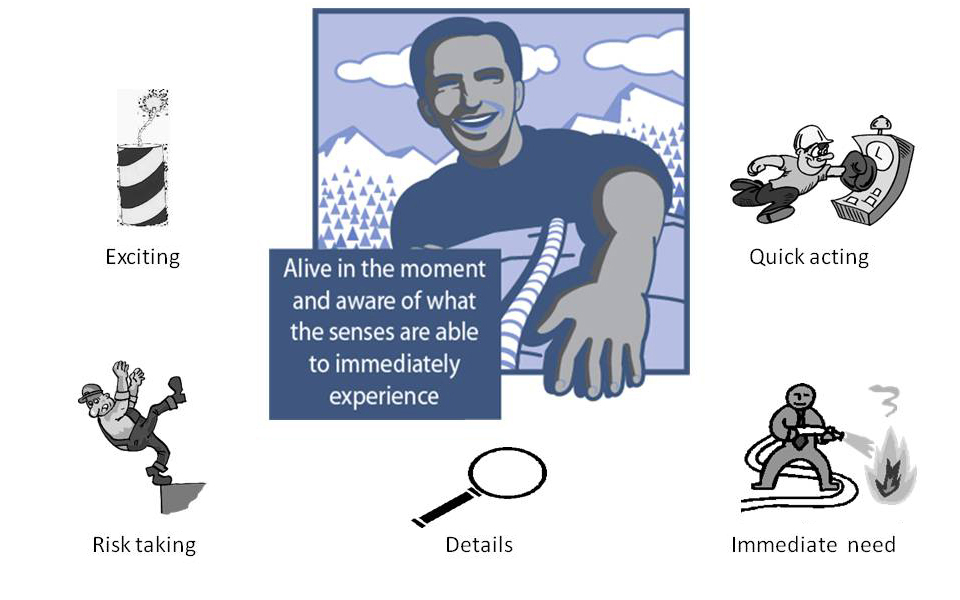
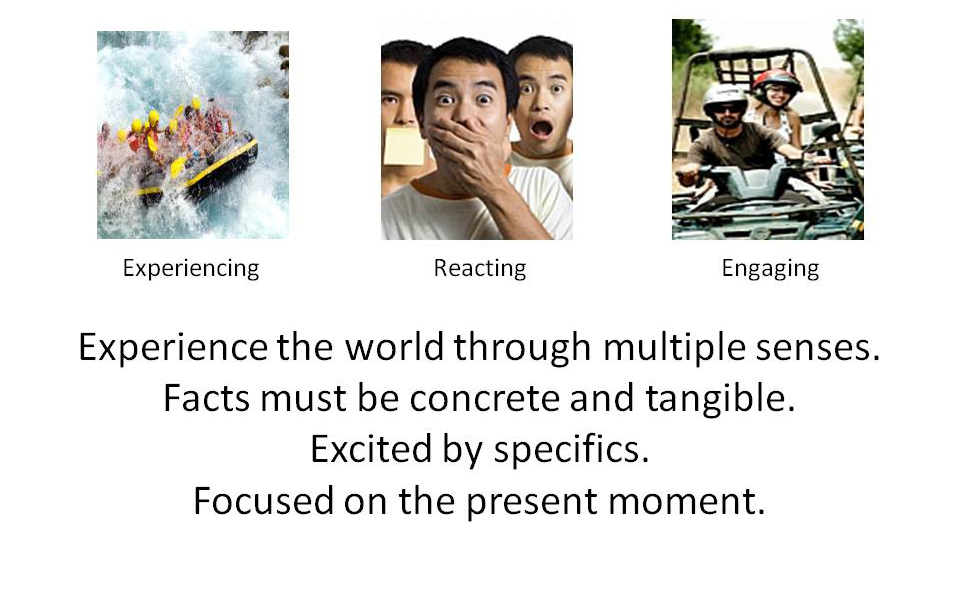 Now is about immediately engaging the world around us. We do this by perceiving information through any of our five senses. We might even be using multiple senses simultaneously. Remember we are talking about concrete information; otherwise, it would not be information we perceived through one of the senses.
Now is about immediately engaging the world around us. We do this by perceiving information through any of our five senses. We might even be using multiple senses simultaneously. Remember we are talking about concrete information; otherwise, it would not be information we perceived through one of the senses.

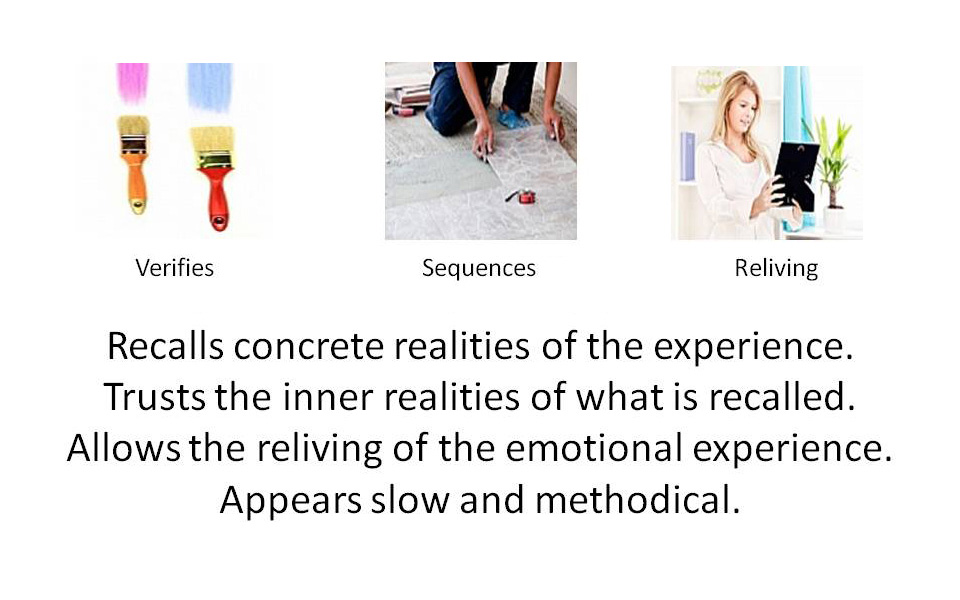 Stabilize is about checking out the present information by comparing it to previous experiences with similar information. We do this by recalling and reliving the past experiences in our lives. These are concrete experiences that include the emotional experiences or reactions we had to the experience being recalled. The recalled experiences are recalled from start to finish and if they are shared everything from start to finish must be shared.
Stabilize is about checking out the present information by comparing it to previous experiences with similar information. We do this by recalling and reliving the past experiences in our lives. These are concrete experiences that include the emotional experiences or reactions we had to the experience being recalled. The recalled experiences are recalled from start to finish and if they are shared everything from start to finish must be shared.
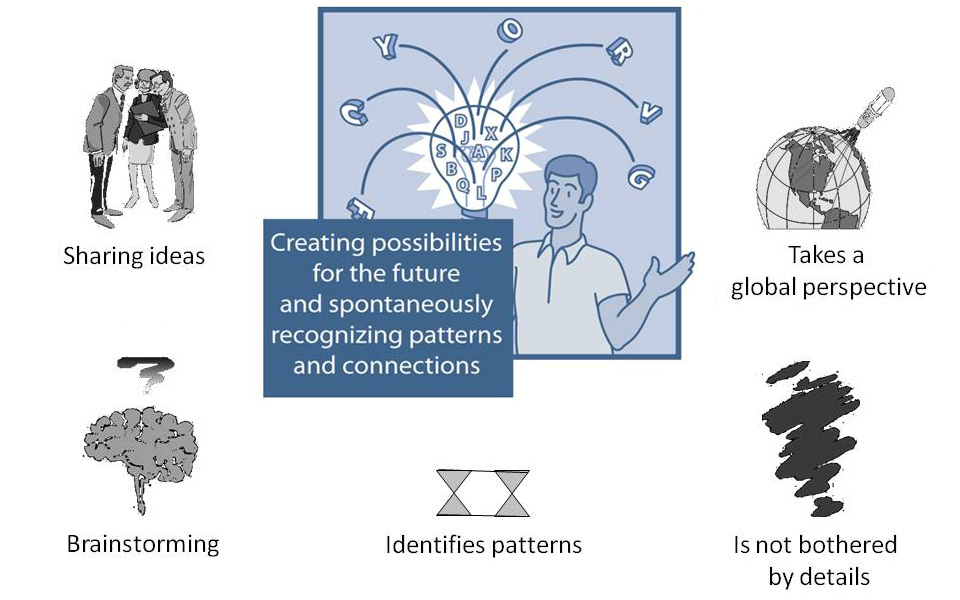
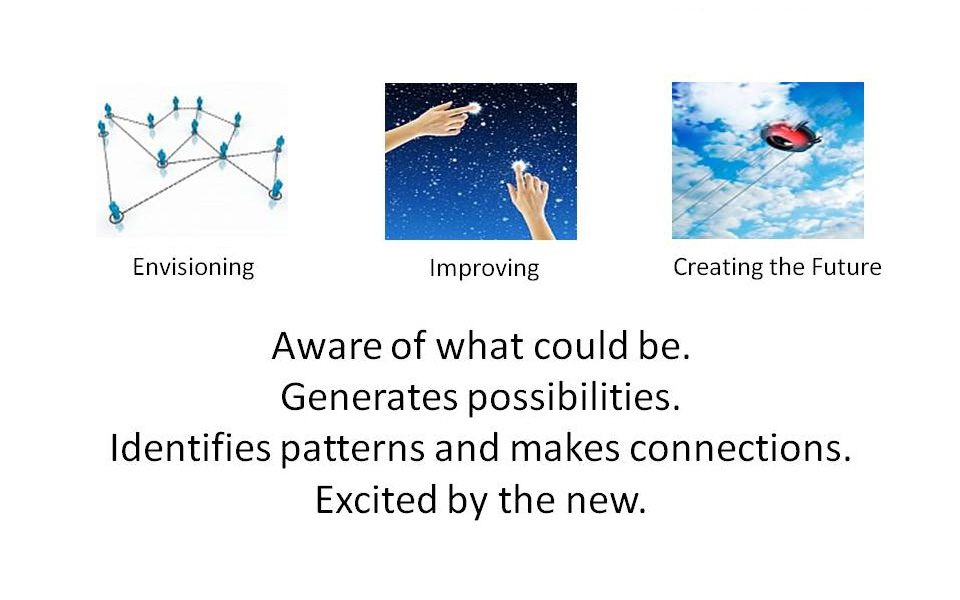 Invent is about identifying possibilities and opportunities related to what is happening in the real world. It is generating new ideas based on old ones. It is creating new ideas based on what someone else has shared. It expands one idea into many possibilities without the need for precision or detail.
Invent is about identifying possibilities and opportunities related to what is happening in the real world. It is generating new ideas based on old ones. It is creating new ideas based on what someone else has shared. It expands one idea into many possibilities without the need for precision or detail.
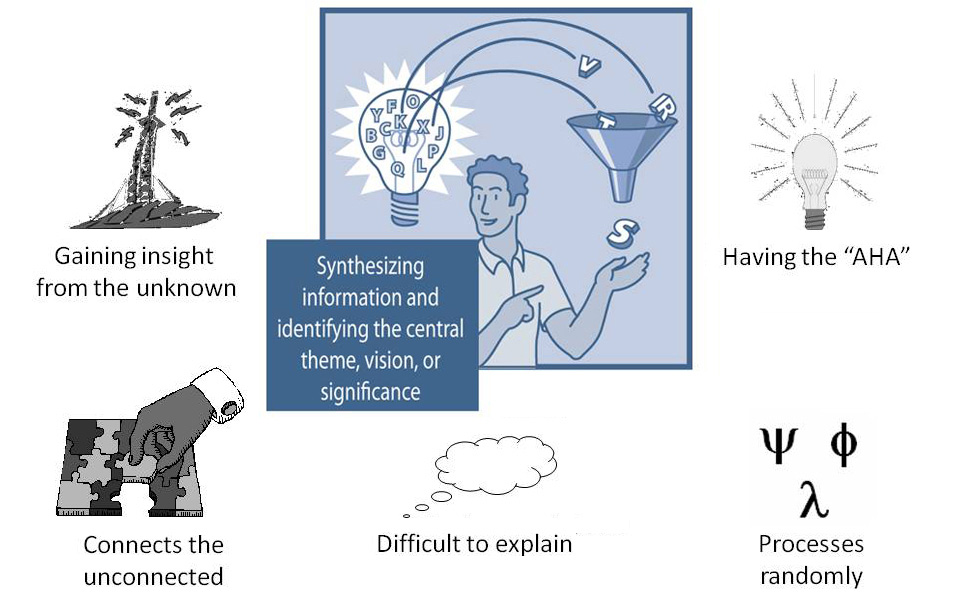
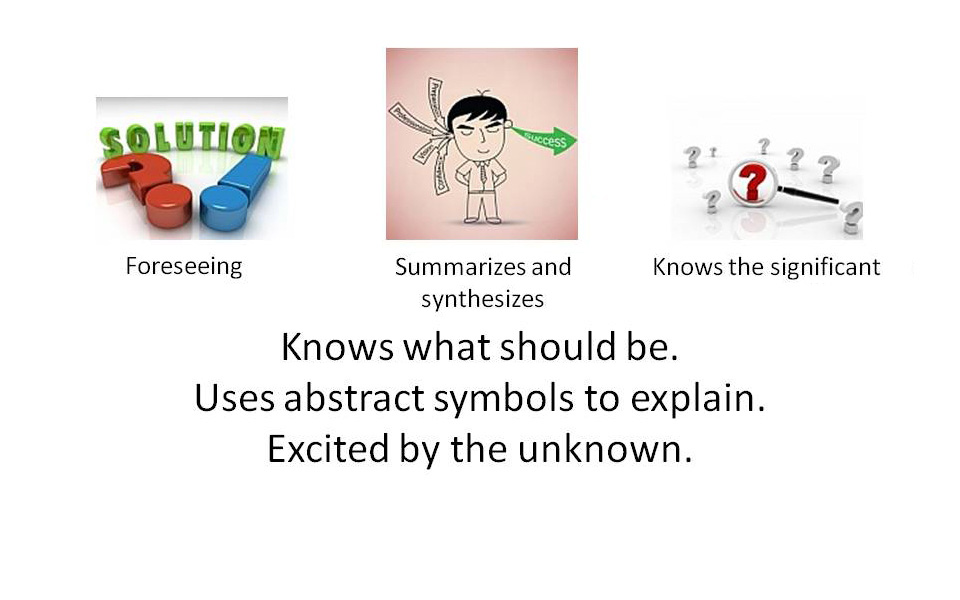 Insight identifies the opportunity or possibility that is the "best" without really knowing how it was identified. It is like a receiver getting signals from an unknown TRUSTED source. It tends not to focus on intermediate steps instead focusing on the end goal. One might connect with Covey's "Start with the end in mind" as an introverted intuiting approach.
Insight identifies the opportunity or possibility that is the "best" without really knowing how it was identified. It is like a receiver getting signals from an unknown TRUSTED source. It tends not to focus on intermediate steps instead focusing on the end goal. One might connect with Covey's "Start with the end in mind" as an introverted intuiting approach.
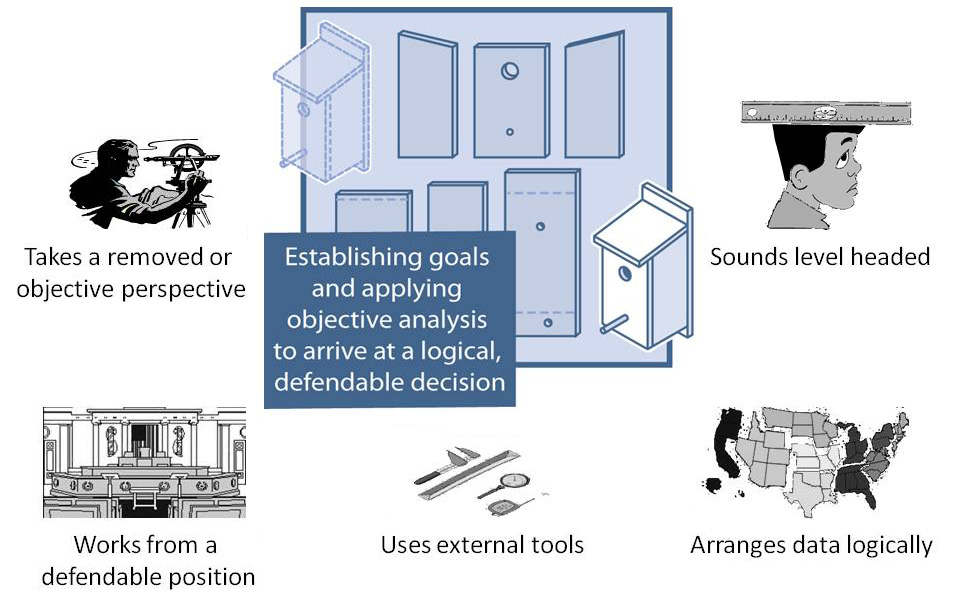
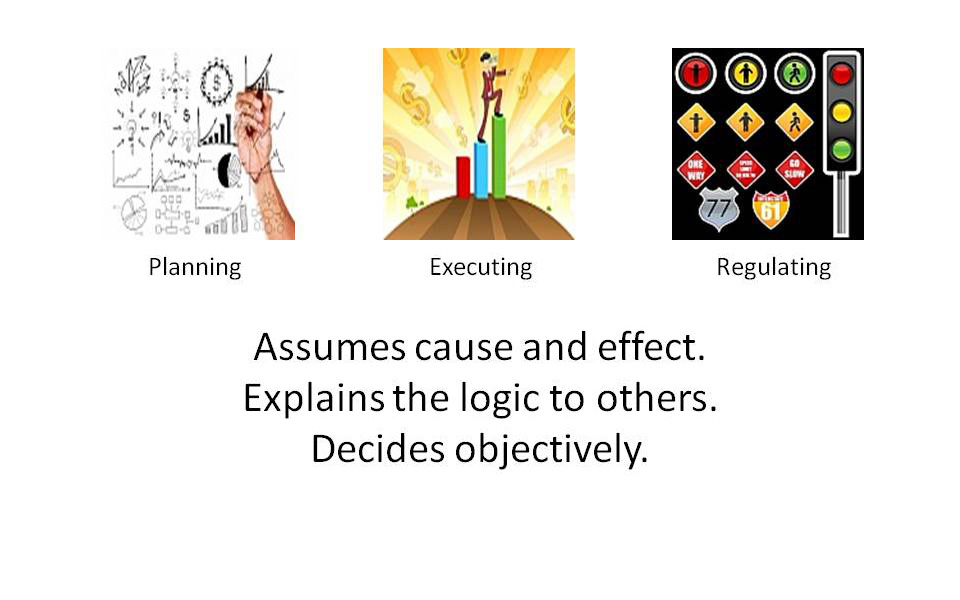 Execute uses accepted tools and techniques to evaluate the information much like surveying instruments are used to determine a specific location. This process organizes information in an orderly manner so the information can be analyzed objectively or impersonally.
Execute uses accepted tools and techniques to evaluate the information much like surveying instruments are used to determine a specific location. This process organizes information in an orderly manner so the information can be analyzed objectively or impersonally.

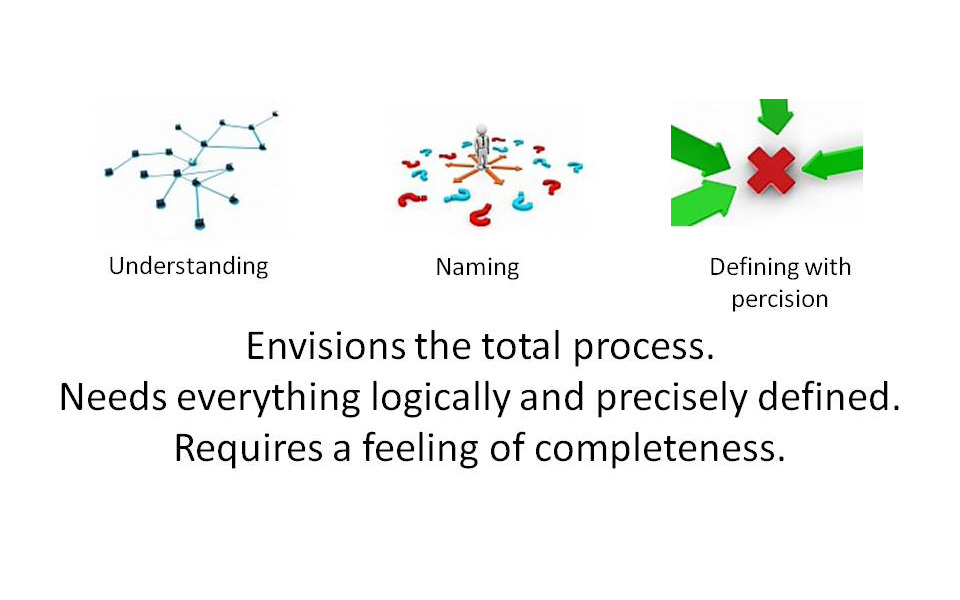 Analyze evaluates information based on how consistently and precisely the information fits within established internal systems or frameworks.
Analyze evaluates information based on how consistently and precisely the information fits within established internal systems or frameworks.
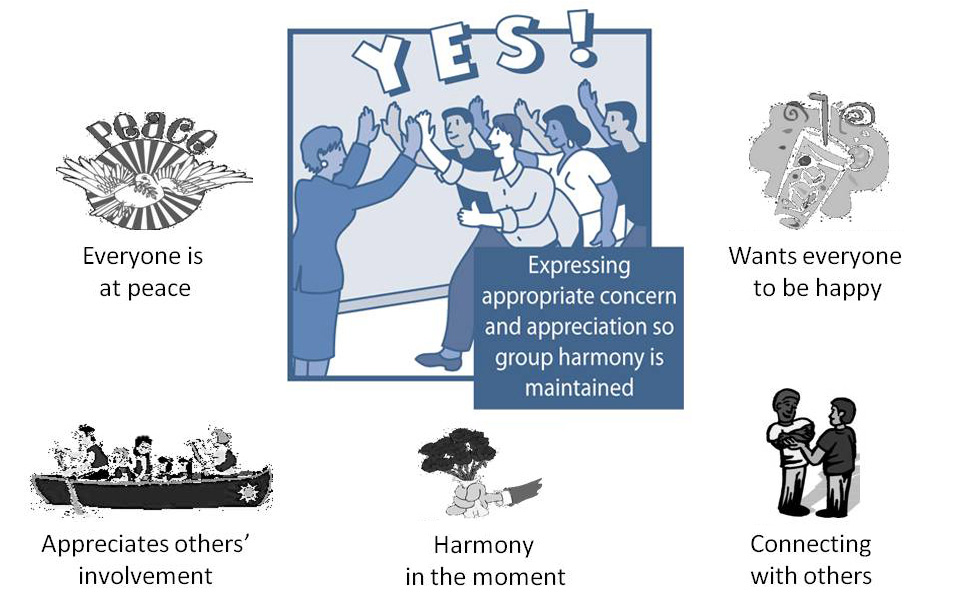
 Consideration is about tuning in/noticing/reading the mood or the practical needs of others and then addressing or satisfying those needs.
Consideration is about tuning in/noticing/reading the mood or the practical needs of others and then addressing or satisfying those needs.

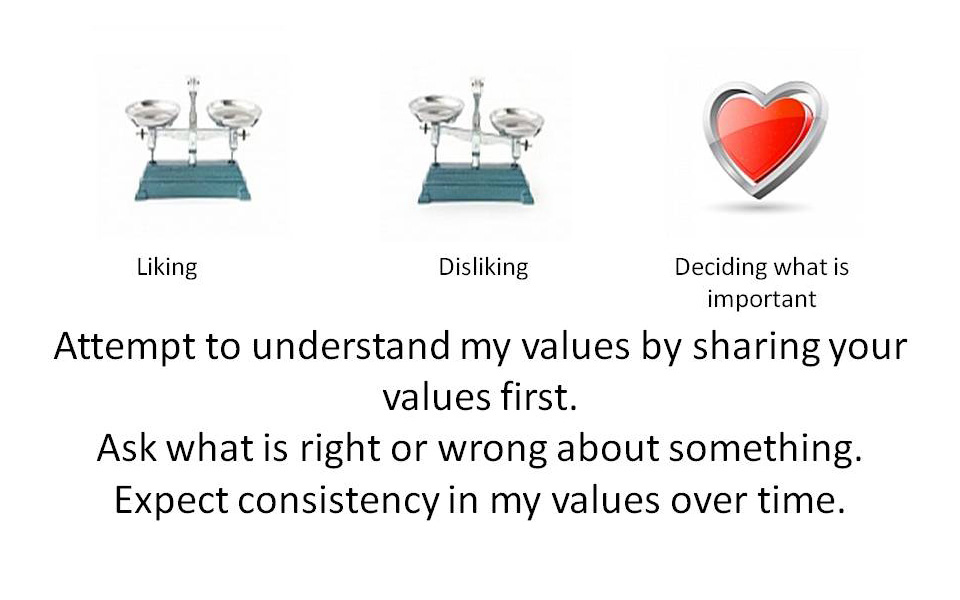 Value evaluates information based on one's unique values. It is easy for one to apply these values to identify what is right, but it is difficult for one to explain to others what one is using to determine what is right.
Value evaluates information based on one's unique values. It is easy for one to apply these values to identify what is right, but it is difficult for one to explain to others what one is using to determine what is right.